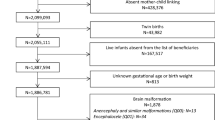Abstract
Increasing evidence suggests that exposure to certain antiepileptic drugs (AEDs) during critical periods of development may induce transient or long-lasting neurodevelopmental deficits across cognitive, motor and behavioral domains. The developing nervous system may endure prolonged chronic exposure to AEDs during pregnancy (in utero) or during childhood, which can lead to neurodevelopmental defects such as congenital neural tube defects, lower IQ, language deficits, autism and ADHD. To date, valproate is the most widely recognized AED to significantly negatively affect neurodevelopment, and demonstrates greater adverse effects than any other AEDs that have been assessed. Although some AEDs appear to have low risk (i.e., lamotrigine, levetiracetam), other AEDs have been implicated in a variety of studies detailed below, and many AEDs have not been adequately assessed. The purpose of this review article is to summarize our current understanding of the neurodevelopmental effects of AEDs.
Similar content being viewed by others
References
Levy R, Mattson R, Meldrum B, Perucca E (2002) Antiepileptic drugs. Lippincott Williams & Wilkins, Philadelphia
Meador KJ, Loring DW (2016) Developmental effects of antiepileptic drugs and the need for improved regulations. Neurology 86:297–306
Lagae L (2016) The importance of assessing behaviour and cognition in antiepileptic drug trials in children and adolescents. Acta Neurol Belg. doi:10.1007/s13760-016-0734-y
Bath KG, Scharfman HE (2013) Impact of early life exposure to antiepileptic drugs on neurobehavioral outcomes based on laboratory animal and clinical research. Epilepsy Behav 26:427–439
Bittigau P et al (2002) Antiepileptic drugs and apoptotic neurodegeneration in the developing brain. Proc Natl Acad Sci 99:15089–15094
Forcelli PA, Kim J, Kondratyev A, Gale K (2011) Pattern of antiepileptic drug-induced cell death in limbic regions of the neonatal rat brain. Epilepsia 52:e207–e211
Yanai J et al (1989) Neural and behavioral alterations after early exposure to phenobarbital. Neurotoxicology 10:543–554
Morte MI et al (2013) Evaluation of neurotoxic and neuroprotective pathways affected by antiepileptic drugs in cultured hippocampal neurons. Toxicol In Vitro 27:2193–2202
Ikonomidou C et al (2000) Ethanol-induced apoptotic neurodegeneration and fetal alcohol syndrome. Science 287:1056–1060
Velez-Ruiz NJ, Meador KJ (2015) Neurodevelopmental effects of fetal antiepileptic drug exposure. Drug Saf 38:271–278
Forcelli PA, Kozlowski R, Snyder C, Kondratyev A, Gale K (2012) Effects of neonatal antiepileptic drug exposure on cognitive, emotional, and motor function in adult rats. J Pharmacol Exp Ther 340:558–566
Verrotti A, Scaparrotta A, Cofini M, Chiarelli F, Tiboni GM (2014) Developmental neurotoxicity and anticonvulsant drugs: a possible link. Reprod Toxicol 48:72–80
Halbsgut LR, Fahim E, Kapoor K, Hong H, Friedman LK (2013) Certain secondary antiepileptic drugs can rescue hippocampal injury following a critical growth period despite poor anticonvulsant activity and cognitive deficits. Epilepsy Behav 29:466–477
AED Pregnancy Registry (2016) http://www.aedpregnancyregistry.org/. Accessed 29 Dec 2016
Meador KJ et al (2006) In utero antiepileptic drug exposure: fetal death and malformations. Neurology 67:407–412
Meador KJ et al (2013) Fetal antiepileptic drug exposure and cognitive outcomes at age 6 years (NEAD study): a prospective observational study. Lancet Neurol 12:244–252
Meadow SR (1968) Anticonvulsant drugs and congenital abnormalities. Lancet Lond Engl 2:1296
Weston J et al (2016) Cochrane database of systematic reviews. Wiley, Hoboken
Harden CL et al (2009) Management issues for women with epilepsy: focus on pregnancy (an evidence-based review): II. Teratogenesis and perinatal outcomes. Epilepsia 50:1237–1246
Bromley R et al (2014) Cochrane database of systematic reviews. Wiley, Hoboken
Baker GA et al (2015) IQ at 6 years after in utero exposure to antiepileptic drugs a controlled cohort study. Neurology 84:382–390
Bromley RL et al (2010) Early cognitive development in children born to women with epilepsy: a prospective report. Epilepsia 51:2058–2065
Rihtman T, Parush S, Ornoy A (2013) Developmental outcomes at preschool age after fetal exposure to valproic acid and lamotrigine: cognitive, motor, sensory and behavioral function. Reprod Toxicol 41:115–125
Nadebaum C et al (2011) Language skills of school-aged children prenatally exposed to antiepileptic drugs. Neurology 76:719–726
Donegan S, Dixon P, Hemming K, Tudur-Smith C, Marson A (2015) A systematic review of placebo-controlled trials of topiramate: how useful is a multiple-indications review for evaluating the adverse events of an antiepileptic drug? Epilepsia 56:1910–1920
Videman M et al. (2016) Evidence for spared attention to faces in 7-month-old infants after prenatal exposure to antiepileptic drugs. Epilepsy Behav 64:62–68
Meador KJ et al (2011) Relationship of child IQ to parental IQ and education in children with fetal antiepileptic drug exposure. Epilepsy Behav 21:147–152
Inoyama K, Meador KJ (2015) Cognitive outcomes of prenatal antiepileptic drug exposure. Epilepsy Res 114:89–97
Adab N et al (2004) The longer term outcome of children born to mothers with epilepsy. J Neurol Neurosurg Psychiatry 75:1575–1583
Bromley RL et al (2013) The prevalence of neurodevelopmental disorders in children prenatally exposed to antiepileptic drugs. J Neurol Neurosurg Psychiatry 84:637–643
Christensen J et al (2013) Prenatal valproate exposure and risk of autism spectrum disorders and childhood autism. JAMA 309:1696
Wood AG et al (2015) Prospective assessment of autism traits in children exposed to antiepileptic drugs during pregnancy. Epilepsia 56:1047–1055
Cohen MJ et al (2013) Fetal antiepileptic drug exposure: adaptive and emotional/behavioral functioning at age 6years. Epilepsy Behav 29:308–315
Glauser TA et al (2010) Ethosuximide, valproic acid, and lamotrigine in childhood absence epilepsy. N Engl J Med 362:790–799
Veiby G, Bjørk M, Engelsen BA, Gilhus NE (2015) Epilepsy and recommendations for breastfeeding. Seizure 28:57–65
Veiby G et al (2013) Exposure to antiepileptic drugs in utero and child development: a prospective population-based study. Epilepsia 54:1462–1472
Meador KJ et al (2014) Breastfeeding in children of women taking antiepileptic drugs: cognitive outcomes at age 6 years. JAMA Pediatr 168:729–736
Author information
Authors and Affiliations
Corresponding author
Rights and permissions
About this article
Cite this article
Kellogg, M., Meador, K.J. Neurodevelopmental Effects of Antiepileptic Drugs. Neurochem Res 42, 2065–2070 (2017). https://doi.org/10.1007/s11064-017-2262-4
Received:
Revised:
Accepted:
Published:
Issue Date:
DOI: https://doi.org/10.1007/s11064-017-2262-4




